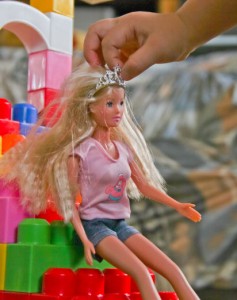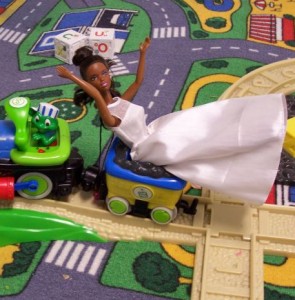This week was the birthday of the Barbie doll. Is it too obvious to use this to inspire some doll play for kids? Any doll, stuffie, or plastic figurine can be part of play, as well as both girls and boys. Kids often have a favorite toy or character. 
No matter what toy children choose, doll play includes a story. Before Barbie, most dolls represented a baby or young child. With baby or young child dolls, that story is naturally about caring for a baby and the child takes on the role of parent or other caregiver.
Despite the controversy about Barbie, she is an adult. Having a grownup doll as a possibility means kids can create a different kind of story. Now, the doll can go to the office, make the decisions, drive the car, talk on the phone, go shopping, and do the things adults do. Through the doll, kids can act out what it’s like to be grown up. They get to make up the story as they play.
When playing with an adult doll, instead of being the parent to a baby, kids can interact with the doll on a grown up level. The scenarios become quite different, as the child and the doll-adult interact. They may go out for coffee, have a conversation as adults do, and decide who will be the boss at work. With two adult dolls, kids can step back and just let the dolls interact. Either way, we can observe how children interpret what adults to and what they think happens when we’re grown up. Often, adult dolls don’t have to go to bed so early.
 Barbie dolls are changing to be more inclusive and realistic. There will now be seven different skin tones and four body types, including one in a wheel chair. Ken is also getting a new image to more closely resemble a dad. The industry is reflecting the diversity of children that play with dolls and how kids play with them.
Barbie dolls are changing to be more inclusive and realistic. There will now be seven different skin tones and four body types, including one in a wheel chair. Ken is also getting a new image to more closely resemble a dad. The industry is reflecting the diversity of children that play with dolls and how kids play with them.
Whether playing with a baby doll, toddler, stuffie, Barbie or character figurine, what’s central to doll play for kids, both boys and girls, is the story. It could one of caring or conflict, a time at home and job or a life and death battle. What engages kids is what is happening in their imaginations. What have you seen as children play with dolls?
